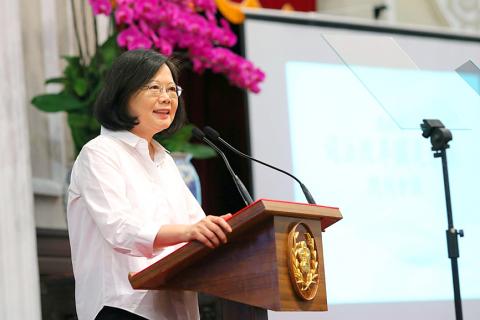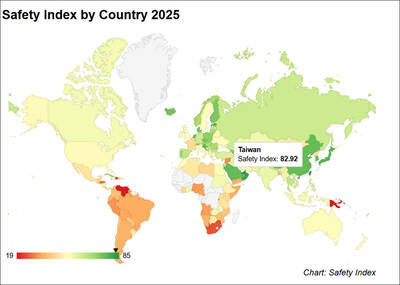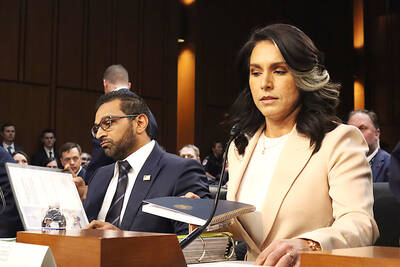The government is to continue efforts to enact sweeping judicial reform, President Tsai Ing-wen (蔡英文) said yesterday, adding that she would personally oversee that the proposed changes are implemented by requesting the Judicial Yuan and the Executive Yuan to report on their progress every six months.
Tsai addressed members of the National Congress on Judicial Reform upon its conclusion, where she outlined five main tasks for her government to set up timetables and take charge of judicial reform.
“The key to judicial reform lies in follow-up actions. I will closely monitor the timetable for the required work and will demand government ministries accelerate the pace and enhance the scope of judicial reform. We shall change the justice system into one the people can rely upon,” she said.

Photo: Lee Hsin-fang, Taipei Times
The first task is to mandate former judge and law professor Lin Tzu-yi (林子儀) to form a public consultation committee, which is to canvass opinions from across society regarding reform progress and provide regular updates to the Presidential Office, Tsai said.
For the second task, Tsai said she is to coordinate between the ministries and the five branches of government, because the reform efforts are to affect all of them and their participation is needed.
The third task is focused on agencies under the Judicial Yuan and the Executive Yuan, which would be asked to present initiatives and policies to implement reforms where no legal amendments are required, she said.
Fourth, Tsai said the Judicial Yuan and the Executive Yuan would be asked to submit regular updates twice a year and present reports to the public on the pace and progress of reform.
The fifth task would require government agencies to present reports to the Legislative Yuan, so that legislators can fully understand the scope of the legal amendments involved, she said.
“Since many of the reform issues are related to the authority and lawmaking mandates of the legislature, we need to have comprehensive dialogue with lawmakers for mutual understanding,” Tsai said.
Mechanisms are to be set up to solicit opinions and suggestions from across society, “so that people who were not part of the process before can also have input. Once some consensus has been reached, then draft bills for legal amendments will be introduced to the legislature for examination,” she said.
“As people know, there was another national congress on judicial reform in the past, where many of the consensuses and proposed measures were not implemented, so today, quite a few members talked about the importance of implementation,” Tsai said.
“They are right. We should not believe that by holding meetings we can solve all the problems. The key to judicial reform lies in follow-up actions. I am the convener for this congress, therefore my responsibility will not end here,” she added.
Tsai was referring to a national effort toward judicial reform in 1999, when the Chinese Nationalist Party (KMT) was in power, presided over by then-vice president Lien Chan (連戰).
Judicial Reform Foundation officials and legal experts had criticized the 1999 round of judicial reform as a waste of time and effort, because despite strong words, promises and a thick report full of recommendations, the KMT government failed to implement the recommendations and made few changes in the follow-up work.

AIR SUPPORT: The Ministry of National Defense thanked the US for the delivery, adding that it was an indicator of the White House’s commitment to the Taiwan Relations Act Deputy Minister of National Defense Po Horng-huei (柏鴻輝) and Representative to the US Alexander Yui on Friday attended a delivery ceremony for the first of Taiwan’s long-awaited 66 F-16C/D Block 70 jets at a Lockheed Martin Corp factory in Greenville, South Carolina. “We are so proud to be the global home of the F-16 and to support Taiwan’s air defense capabilities,” US Representative William Timmons wrote on X, alongside a photograph of Taiwanese and US officials at the event. The F-16C/D Block 70 jets Taiwan ordered have the same capabilities as aircraft that had been upgraded to F-16Vs. The batch of Lockheed Martin

GRIDLOCK: The National Fire Agency’s Special Search and Rescue team is on standby to travel to the countries to help out with the rescue effort A powerful earthquake rocked Myanmar and neighboring Thailand yesterday, killing at least three people in Bangkok and burying dozens when a high-rise building under construction collapsed. Footage shared on social media from Myanmar’s second-largest city showed widespread destruction, raising fears that many were trapped under the rubble or killed. The magnitude 7.7 earthquake, with an epicenter near Mandalay in Myanmar, struck at midday and was followed by a strong magnitude 6.4 aftershock. The extent of death, injury and destruction — especially in Myanmar, which is embroiled in a civil war and where information is tightly controlled at the best of times —

Taiwan was ranked the fourth-safest country in the world with a score of 82.9, trailing only Andorra, the United Arab Emirates and Qatar in Numbeo’s Safety Index by Country report. Taiwan’s score improved by 0.1 points compared with last year’s mid-year report, which had Taiwan fourth with a score of 82.8. However, both scores were lower than in last year’s first review, when Taiwan scored 83.3, and are a long way from when Taiwan was named the second-safest country in the world in 2021, scoring 84.8. Taiwan ranked higher than Singapore in ninth with a score of 77.4 and Japan in 10th with

SECURITY RISK: If there is a conflict between China and Taiwan, ‘there would likely be significant consequences to global economic and security interests,’ it said China remains the top military and cyber threat to the US and continues to make progress on capabilities to seize Taiwan, a report by US intelligence agencies said on Tuesday. The report provides an overview of the “collective insights” of top US intelligence agencies about the security threats to the US posed by foreign nations and criminal organizations. In its Annual Threat Assessment, the agencies divided threats facing the US into two broad categories, “nonstate transnational criminals and terrorists” and “major state actors,” with China, Russia, Iran and North Korea named. Of those countries, “China presents the most comprehensive and robust military threat